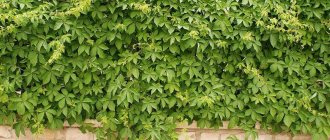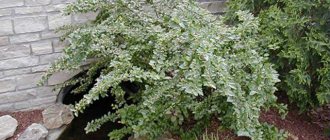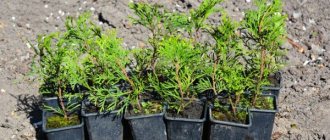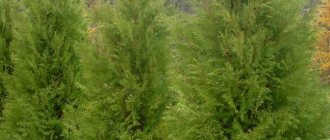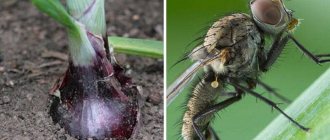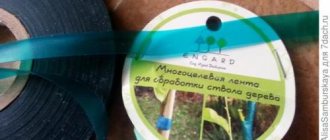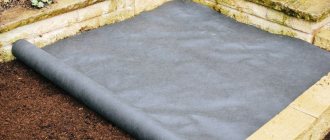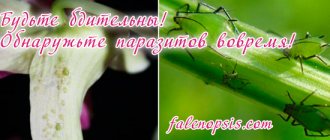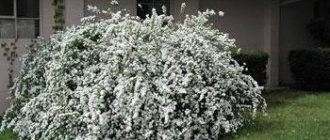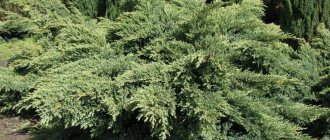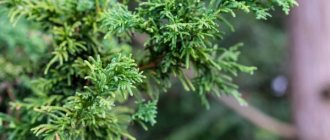Home/Flowers and Plants/Living fence: the best options for a coniferous fence on your site
A hedge is an excellent alternative to fencing made of wood, corrugated board, chain-link, etc. “Living” fences made of coniferous plants are in particular demand.
Their branches are dense and prickly, which allows you to protect the area not only from the prying eyes of neighbors and passers-by, but also from the penetration of uninvited guests.
There are a lot of options for coniferous plants that can be used as a hedge. Below we have selected 11 of the best candidates, all you have to do is make the final choice and decorate your yard in such an original way.
Prickly spruce
This type of spruce has excellent external and functional qualities. It tolerates so-called shearing well, and is capable of forming an impenetrable thorny fence like a wall.
Prickly spruce grows slowly, so you will have to wait for the “living” fence to reach the desired height. But it is resistant to smoke, gas, dust and soot, which allows it to be planted in urban environments.
Choosing a plant for a living fence
The choice of plant for a living fence depends on what kind of fence you want to create: high (from 2 m), medium (0.5–2 m) or low (up to 0.5 m). If you want to build a hedge that will change throughout the year, give preference to deciduous trees and shrubs; otherwise, purchase seedlings of evergreen species.
Let's look at the most popular plants that are used to build living fences at dachas in our country.
Trees are the best choice for large areas.
- And you. They are used most often. There are more than 100 species of willows. They are suitable for erecting high and medium height hedges.
One of the most popular and interesting solutions is a mesh fence made of willow shoots.
Photo No. 1: living willow hedge
Work on the construction of such a fence should be carried out in the spring. Dig a trench (depth - 25–30 cm) and fill it with fertile soil. Simply install the rods that have been in the stimulator for several days in the ground. Within a couple of weeks, the cuttings will begin to grow on their own. To give the fence the desired shape, dig in supports, stretch wire between them and secure the rods.
Using this technology, you can even build a very high fence.
Photo No. 2: high fence made of willows
- Coniferous species. They are ideal for creating evergreen walls.
- Ate. They tolerate severe frosts well and can grow in constant shade. These trees are planted on fertile and moist soil.
- Yew. Ideal for the western and southern regions of Russia. Please note that yew berries are poisonous. If there are small children in the house, then you should not plant these plants. For normal development, the plant needs fertile soil.
- Thuja. It comes in two types. Fences made from oriental thuja (biota) are more common, because its seedlings are cheaper and easier to obtain. With regular trimming and under optimal conditions, you will have a thick, light green wall in a few years.
Photo No. 3: fence made of oriental thuja
If you want to see a narrower fence on the site, you will have to look for Western columnar thuja seedlings. At the same time, the price of erecting a hedge in Moscow will increase.
Photo No. 4: a fence made of columnar thuja
Linden, maple, elm and other species are also used to build living fences. Preference is given to species whose height does not exceed 4 m. Large trees look sloppy. In addition, they are more difficult to care for.
Norway spruce
The next variety of spruce is in no way inferior to the previous version. If the ordinary one was created in order to be used as a hedge.
With a dense planting pattern, the walls of the fence do not even need to be cut; the branches of the spruce will seem to “intertwine” with each other and become an impenetrable wall even for small animals. This density is ensured by a lush crown, which begins its growth from the ground.
Features of a pine fence
Pine hedges have won the admiration and recognition of many landscape designers and their clients. However, when erecting a pine fence, it is important to remember some nuances:
- It is rational to locate a strip of pine trees on the northern side of the territory. There, the precious seedlings will not be scorched by the sun, and when the pines grow up, they will become excellent protection from snow and winds. At the same time, the site will not be dark during the day, since the trees that grow from the north do not create shadow.
- The choice of pine seedlings must be approached very carefully. Many people take advantage of the inexperience of buyers and, instead of quality-grown seedlings, sell specimens dug up in the forest. Of course, there is nothing wrong with forest pines, but they are not suitable for hedges. The difference between high-quality planting material is a well-developed root system.
- The ideal age of a seedling for a hedge is three years. If a hedge is erected from Scots pine, then the length of the tree should not exceed half a meter.
Common juniper
This type of shrub is valued for its ability to improve the quality of the soil in which it grows. Despite its slow growth, the common juniper is in great demand, because it is considered almost “eternal”.
Since pests are not interested in it, it will easily live on your estate for many decades. Due to the fact that this variety of juniper lends itself well to pruning, it can be grown both as a full-fledged fence and as a low-growing border.
How to make a living fence
Many owners of country houses and summer cottages ask how to make a living fence. There is no definite answer, because each plant requires an individual approach. It all depends on your desires, possibilities and how exactly you imagine a practical and beautiful fence built with your own hands.
For example, you can place perennial climbing plants under an existing chain-link fence to create a hedge that will delight you throughout the summer.
Photo No. 9: living fence on a chain-link mesh
Planting trees along the outside or inside of the fence will also add curb appeal to the area.
Photo No. 10: planting trees along the fence
Regardless of what kind of living green fence you are going to build, pay attention to the following points.
- Before you start, plan everything carefully and study the features of growing the selected breeds.
- In the first year of life, a hedge requires special attention, regular watering and fertilizing with organic fertilizers.
- Choose seedlings of the same size and age. The fence will gradually increase in size.
- Familiarize yourself with the laws governing the construction of fences and planting.
Juniper Cossack
The second option for juniper for creating a hedge is the Cossack variety. It is relatively low (up to 1 meter), so it is often used as a border “fence”.
The branches are very dense and spreading, so it is necessary to plant Cossack juniper bushes at a distance of at least half a meter from each other, and then trim them regularly. Ideal for planting on rocky, sandy and chalk soil.
Larch
A fast-growing hedge of larch is rarely created, since in winter the plant sheds its needles. The height of the tree can reach 40 m, its crown is cone-shaped. Young needles have a light green color, in the fall they acquire yellow-golden shades, they are very soft to the touch. Larch is not picky about climate and soil.
larches
It can grow well in permafrost, with gassed, polluted air. The plant feels best in drained, moist, fertile soils in unshaded areas. Under such conditions, larch can grow up to 1 m in height per year. If the conditions are less comfortable for the tree, it will not be very tall and stunted.
Red cedar
A sibling of the previous juniper, the Virginia variety also lends itself well to crown formation and retains its original shape.
Cone berries grow on the hedge - the fruits of the Virginia juniper, which increase its decorative properties. In addition, the advantages of this variety include its undemanding nature to the soil, so you can grow a hedge from it in dry, infertile, and even calcareous areas.
Maintaining the desired crown shape
If the tree has enough space, then the crown turns out wide with free development. The peculiarity of pine is that it does not produce additional shoots after pruning: it does not “fluff”. To form a crown, you need to set the direction of branch growth. Do-it-yourself aspen hedge? To do this, use a chain-link mesh, using it to limit the shape.
The branches are also tied together with wire and tied 4-5 times during the summer, otherwise it cuts into the trunk and leaves ugly scars.
One of the main problems is slowing growth. In nature, trees reach 42 meters, and at a young age (the first 10–15 years) they add up to 40 cm every year. Young shoots of plants are pinched.
They do this in the spring. Old branches (three years and older) are pruned only if absolutely necessary: the tree may become sick or die. For hedges take slow-growing forms:
Thuja occidentalis
Of all coniferous plants, recently it is the thuja that has become most often used as a hedge. High growth (from 1 to 4 meters), beautiful shape and evergreen branches attract buyers. The thuja tolerates a haircut very well, and afterwards maintains the given shape for a long time.
This type of coniferous shrub is unpretentious to the ground and can easily live on sandy, sandy loam and clay soils. A distinctive feature is maximum resistance to pests and diseases.
Preparing for landing
Once the planting site has been chosen and the seedlings have been purchased, you can begin preparing the soil. Pine cannot be called unpretentious; it needs comfortable conditions and light, non-acidified soil. If there is clay soil on the northern side of the site, preliminary preparation is not necessary.
The next stage is marking the site. A hedge of spruce trees from the forest? It is important to maintain a distance between seedlings, optimally one and a half meters for dwarf varieties and about 4 meters for tall pines. It is better to plant pine trees in a checkerboard pattern. Holes for planting should go to a depth of 50 cm to one meter.
It must be remembered that pine is a tree that grows mainly upward, and does not fluff out to the sides.
The seedlings are placed in holes, covered with a mixture of peat, sand and humus, buried in soil and thoroughly watered with fresh water. When planting, it is necessary to carefully examine the specimen for damaged and diseased shoots. If any are found, it makes sense to carefully remove them with pruning shears.
The third stage of hedge formation is necessary in cases where the Scots pine variety is selected. Using a special frame, rigid wire or chain-link mesh, you need to strengthen the crown of each seedling, otherwise it will later become uneven and ruin the whole look.
After the planting is completed and the crowns are formed, you can lightly trim the pine trees, however, you should not get carried away. The pine tree does not become more magnificent after pruning; a new one grows in place of the removed shoot, but nothing more. Trimming is appropriate when some branches are damaged or stand out too much from the overall pattern, as well as when seedlings are growing rapidly.
Lawson's cypress
The honorary title of “star” of a coniferous fence is rightfully occupied by the Lawson cypress. This shrub is very popular in European countries due to its unusual color. In the hands of a master, cypress easily turns into formed picturesque hedges and walls.
It has various crown shapes (narrow-conical, columnar and dwarf), which is convenient for planting and forming free-growing plantings. During the first 5 years, the Lawson cypress grows quite slowly, after which the speed of development doubles.
Spruce conical
An interesting and very unusual variety of spruce that attracts attention with its appearance. If you plant shrubs of this variety at a distance of approximately 1 meter, then after a while you can get a compact, dense hedge with a pyramidal crown.
Quite sensitive to the external environment and soil, does not like the active influence of ultraviolet radiation in the spring and smoke, and is susceptible to aphids and red spider mites.
Further care of the hedge
When the pine hedge is planted, you can begin preparing for further care. As mentioned above, coniferous trees are not among the unpretentious ones, so it is necessary to carefully monitor their growth and follow a number of care rules:
- Regular weeding. There should be no weeds at the planting site. If they appear, you should immediately remove them from the roots. You should not use a hoe for this, as the roots will remain in the soil and there will be twice as many weeds.
- Watering the hedge should be done every two days.
- You can fertilize seedlings with nitrogen and phosphorus additives, especially if the trees begin to wither or lose color.
- Trimming shoots to form the correct shape of a pine tree is only permissible in the spring and autumn seasons. This should not be done in the summer!
- In hot weather, watering and irrigating the branches should be most intense.
- If some branches begin to dry out, they should be carefully removed using garden shears.
Features of cutting pine trees can be learned from this video:
Growing a pine hedge is not an easy task, but if you put in every effort, carefully monitor and care for the trees, the result will be simply amazing. A beautiful living fence will protect you from prying eyes, create an atmosphere of comfort, improve the area and purify the air.
Yew berry
Masters of topiary art idolize yew, because even in the Renaissance, people realized that this plant perfectly supports any haircut, be it molded or curly.
Nowadays, berry yew is used to create single-row borders, “living” fences or walls. Despite the fact that the yew grows very slowly (in the first couple of years the yew grows by 3-4 cm), its height can reach 8 meters.
It is practically not subject to diseases, pests and weather conditions, which extends its lifespan not even by tens, but by hundreds of years. During the fruiting period, which lasts from late summer to late autumn, it has high decorative properties.
Living fence made of trees or shrubs
A living fence made of trees or shrubs - it's up to you. Almost any type of green fencing can be made attractive and functional. Come up with an interesting composition or plant a tall and thorny bush behind a standard fence. The choice is up to you.
Remember that living fences made from plants that are demanding of environmental conditions require constant care. They need to be watered, trimmed and fertilized. The appearance of the site will depend only on you.
Owners of small cottages will not have any particular problems caring for their plants, but owners of large areas who want to build a fence or an evergreen garden should think about hiring a professional worker.
Siberian fir
This type of needles is suitable for creating free-growing living fences. Thanks to the purple color of megastrobiles and the yellow-red palette of microstrobiles, Siberian fir has high decorative properties in the spring.
As for the soil, it is preferable to plant this plant in fertile, moderately moist soil.
Siberian fir has a negative attitude towards flue gases and does not tolerate soot well, so it is not advisable to grow it in urban conditions.
Conifers for hedges: harvesting seedlings
Conifers are propagated by cuttings, carried out exclusively in greenhouses, because frost-resistant plants love warmth very much in the initial periods of their life. It is better to plan planting in early spring, when the buds are just swelling. During this period, vital juices reach their peak, which allows them to better “cling to life”, germinating more efficiently. There are two types of cuttings: lignified, green. Lignified ones grow faster, cuttings are taken in greenhouses in the fall and winter. Most of them take root safely after two to three months, if the watering and fertilizing system is properly balanced. Decorative forms are often grafted, but it is much more difficult for an amateur gardener to carry out such a procedure.
Mountain pine
Our list of the most suitable coniferous plants for creating a hedge ends with mountain pine. This beautiful plant has a wide branch span, so it is recommended to use it only for creating free-growing borders and fences.
Trimming mountain pine is useless, since this procedure does not affect the increase in the degree of branching and crown density.
It is recommended to plant this type of pine at a distance of half a meter from each other so that the branches do not intertwine and become smaller. Mountain pine is not picky about soil and the environment, so it takes root well in urban conditions.
AllaAuthor of the article
Did you like the article?
Share with your friends:
Planting a hedge in several rows
For an impenetrable (“you can’t get your hand through”) fence, conifers are planted in a checkerboard pattern. They make single-row, double-row, and less commonly, three-row hedges. Many plants, for example, thuja, cannot be planted in three rows: the middle row dries out.
When planting in multiple rows, alternate plants that grow freely and those that need pruning.
The hedge is decorated with figures made from thuja or other plants that are easy to trim. Norway spruce hedge photo? To do this, they put wire frames on them (sold in stores) and cut off the branches protruding outward as they grow. Having mastered the basics, they proceed to complex forms.
This work requires skills that are difficult to obtain quickly on a personal site, since the result of efforts is visible only after several months, and sometimes years.
In order for the hedge to overwinter well, thujas and cypress trees are covered with non-woven materials (wrapped) or wooden boxes, and the top is tied with a rope so that the snow does not crush it and make them disheveled. This helps maintain the shape of the hedge. It should also be remembered that cutting plantings more than 60 cm wide without professional equipment is difficult.
If you are planning a large-scale green installation, it is better to entrust it to landscape design professionals.
A hedge can partially or completely replace a standard fence, while providing not only protection, but also... Further
Green fences along the property line can be grown from free-growing plants that do not require additional removal. Further
When deciding to grow a green fence on the borders of your property, you can choose plants that will not only create a dense border. Further
The design of green fences does not always include a rigid crown, the presence of thorns and a menacing appearance. Some owners. Further
White dogwood is beautiful in all seasons. In summer, its lush spreading crown is decorated with white and cream fluffy ones. Further
A whole army of designers and gardeners is involved in the design of landscape design for city parks and squares, and the resulting landscape is... Further
The air is filled with the smell of coniferous trees - what could be more pleasant and healthy when you relax in your own. Further
